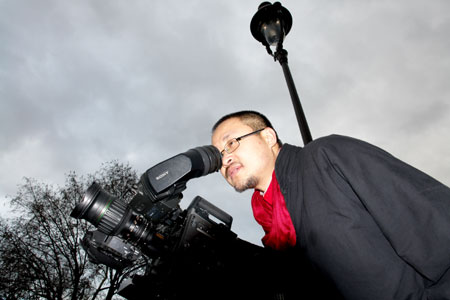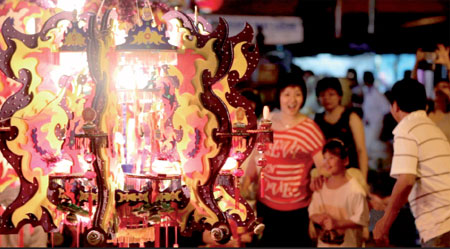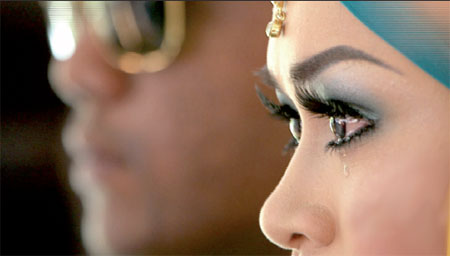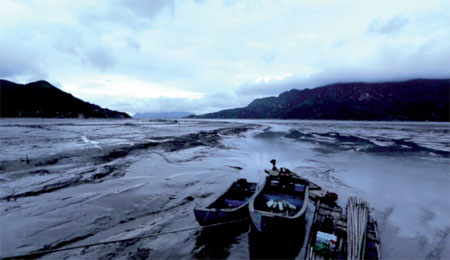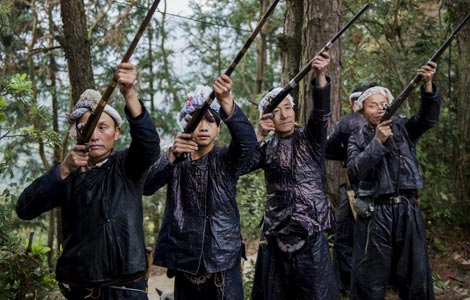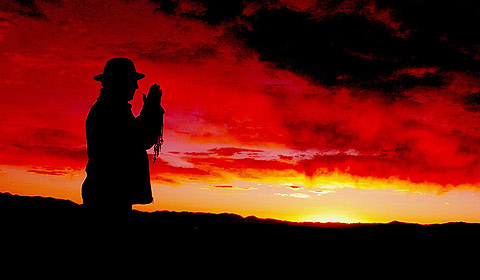Nanyang odyssey
Updated: 2013-12-19 08:15
By Raymond Zhou (China Daily USA)
|
||||||||
Documentary filmmaker Zhou Bing reveals his secrets about bringing the subjects of his work closer to audiences far removed from his field of study, writes Raymond Zhou.
Zhou Bing has lots of friends in Southeast Asia. When they have a party, his friends would use multiple languages to talk to different people in the same room. "Many of them can speak seven languages and dialects, including Mandarin, Cantonese, Hakka, Fuzhou dialect, southern Fujian dialect, Malay and English. They would keep on switching from one to another and sprinkle one language with words from others," explains Zhou, a documentary filmmaker. Zhou spent much of the past three years visiting nine countries in Southeast Asia that are collectively known as "Nanyang" in Chinese. It was the destination of many Chinese emigrants in the old days. Zhou and his team embarked on a mission to chronicle the current lives of these people as well as the history of their ancestors.
The result, South of the Ocean, has been broadcast on the History Channel in the United States. That was a two-hour highlight, and the full-length 10-episode version will hit the airwaves on the documentary channel of China Central Television.
"Nanyang is a mirror, which can reflect not only China's past, but its present and future," says Zhou. "Once you mingle in that society, you'll know how our ancestors lived and their customs, including how they decorated their homes and worshipped their gods. Even traditional holidays we celebrate today are more elaborate and complicated over there."
Zhou is especially impressed by the popularity of ancestral halls that dot urban and rural landscapes in Nanyang.
"These venues are not just collective homesteads of antiquity, but still have many functions. A new arrival can stay there, and get help in job hunting or even obtaining loans for a business startup. After you make it big, you can donate to the organization. Many of the big halls run schools and other nonprofit activities. In Malacca, a town with a small population, it is like a senior citizens' entertainment center, where people sip tea and sing karaoke."
Many of the customs can be traced back to the Ming Dynasty (1368-1644), but tanghao probably originated in the Song (960-1279) or even earlier Han Dynasty (206 BC-AD 220), analyzes Zhou. "It refers to your ancestral root. So, you'll see posted on some doors place names, such as Yinchuan or Dunhuang far in northern China. Young people in China have never heard of such a practice or even the name tanghao."
Not only are Zhou's documentaries richly informative, but they employ a film language that is lavish and engaging. "One of my collaborators is a graduate from film school and I share with him the notion that our work should resemble a European art film in visual style," he says.
In South of the Ocean, made for a total cost of 24 million yuan ($4 million), some of the images, including the aerial shots, are so eye-catching they would not be out of place in a big-budget feature film.
Ten years ago, Zhou made The Forbidden City, a 12-episode documentary that made extensive use of dramatization and computer imagery. The enormity of the project and its huge influence turned it into a milestone in Chinese documentary filmmaking.
"We had been trying to learn the creative model of National Geographic, and by 2003 we had the chance to work with them. We designed The Forbidden City to appeal to a global audience," Zhou recalls. "If we want Chinese arts and culture to be accepted by mainstream Western media, we have to find out, in concept and technique, the international way of communication."
When making South of the Ocean, the techniques and technologies had advanced, but the concept remains the same, such as the visual style, the quality of the shots and editing and narrating skill should be up to the par of a good feature film, says Zhou.
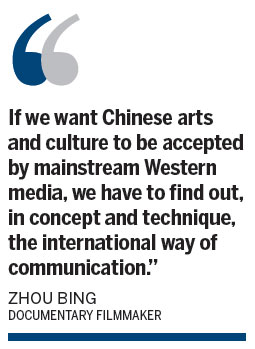
However, in the decade of exploring a global market, Zhou has found that there is no single "Western market". Every country and every channel has its own distinctive features. "Take the pace of storytelling and editing. Documentaries shown on American channels are the fastest. France and Germany are somewhat slower. NHK of Japan is the slowest, even slower than those in China."
Zhou joined China Central Television in 1993 as a producer for its news magazine that followed the highest rated evening news program. The CCTV show was mostly investigative, but occasionally it would feature scholars, writers and artists. The diversity of the show provided him with opportunities to tap into his fields of interest.
"I was lucky that I found myself in a work environment that encouraged me to do what I loved to do."
In the ensuing years, he made multiple-episode documentaries on the Dunhuang Grottoes; the Peking Opera legend Mei Lanfang; the Bund in Shanghai; the Louvre; the Palace Museum of Taipei; and, of course, the wildly successfully Forbidden City series.
About half of the projects were commissioned rather than initiated by himself, but they all enticed him with challenges. One of the challenges is the mountain of information from which he has to cull the most relevant and most exciting to be used in his films. He does not shove it to a team of researchers, but would conduct the in-depth probe himself so that he has a firm grasp of the subject matter.
For the first episode of The Forbidden City, for which he wrote a 6,000-word script, he devoured historical documents to the tune of more than a million words. "We even made discoveries that went beyond what the scholars knew, so our film benefited their research."
Zhou experimented with the BBC format of using an expert who acted as a guide for his film on the Great Wall. But he is not optimistic about the format in China because, as he sees it, it would require talents who must project trustworthiness and eloquence as well as knowledge and erudition. "Most of the time, we would use a narration and a voice-over that is a friendly third person and an all-knowing god, sight unseen."

For his next project, Zhou intends to make a film on traditional Chinese medicine, which will ruffle a few feathers as the topic is polarizing.
"I'll incorporate differing views on it," he notes. But above all, he wants to show TCM as "part of China's ancient value system and a vital expression of the culture".
He even dreams of venturing into the realm of fictional feature films, but it has to be about ancient Chinese history and he does not trust others to do the script for him.
"It must be the Chinese cultural genes inside me. Whether I do a documentary or a fictional feature or even a cartoon, I want it to carry on traditional culture and values. It can be entertaining and it must have strong aesthetics, but ultimately you're responsible for contributing to the cultural heritage. It's a burden I carry on my shoulders."
The series will air on CCTV9 from Dec 20 to 29, with one new episode per night at 10.
Contact the writer at raymondzhou@chinadaily.com.cn.
|
Zhou Bing's latest documentary, South of the Ocean, sheds new light on the past, present and future of Chinese emigrants' lives in Southeast Asian countries. Photos Provided to China Daily |
|
The Mid-Autumn Festival celebration plays a big role in the life of ethnic Chinese living in Singapore. |
|
Traditional culture like this Malaysian wedding is one of the highlights of the 10-episode documentary. |
|
Zhou Bing and his team visit nine countries in Southeast Asia to shoot South of the Ocean. |
(China Daily USA 12/19/2013 page7)

 Former NBA player may coach in DPRK
Former NBA player may coach in DPRK
 Misses International shine in Tokyo
Misses International shine in Tokyo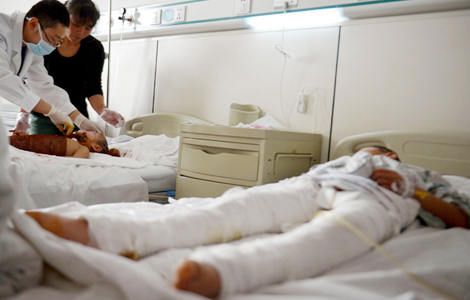
 Parents urged to supervise children's TV-viewing habits
Parents urged to supervise children's TV-viewing habits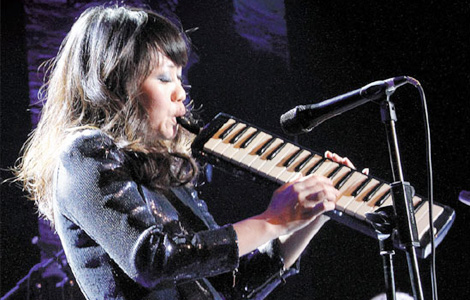
 Jazzing up Beijing
Jazzing up Beijing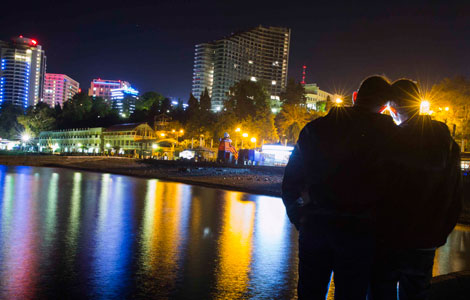
 US delegation to Sochi includes gay athletes
US delegation to Sochi includes gay athletes
 Snow storm wallops NE USA
Snow storm wallops NE USA Russia to bail out Ukraine for $15 billion
Russia to bail out Ukraine for $15 billion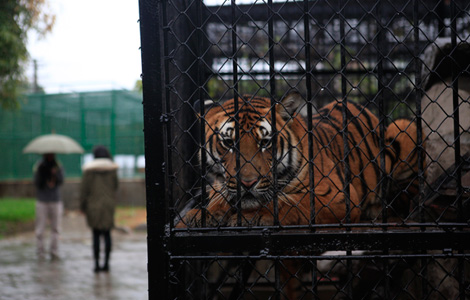
 Fatal tiger attack 'points to flaws in zoo management'
Fatal tiger attack 'points to flaws in zoo management'
Most Viewed
Editor's Picks

|
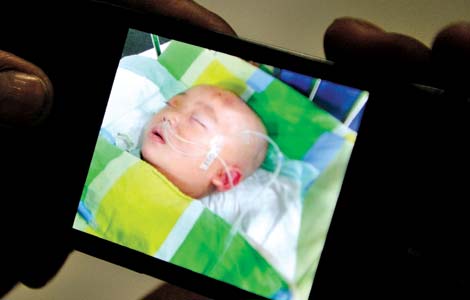
|

|

|

|
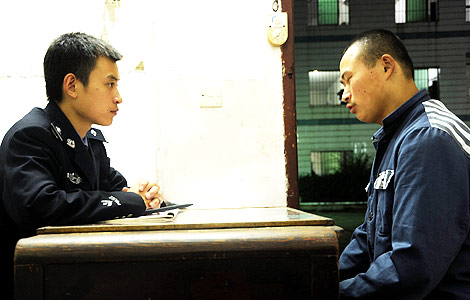
|
Today's Top News
Baucus likely next ambassador to China
Senator Baucus to be named ambassador to China
Treasure Island still radioactive?
Military plays down 'near-miss' between warships
Fed to cut bond purchases by $10B
Overseas investing sees large jump
China expands research in Antarctica
Cloud seeding plans spark debate
US Weekly

|

|
